Jenny Diver
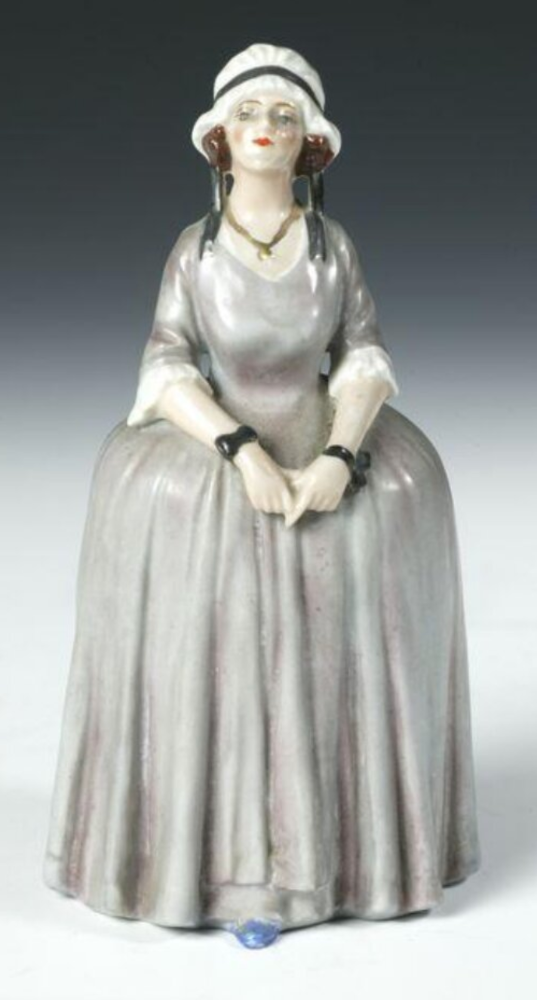

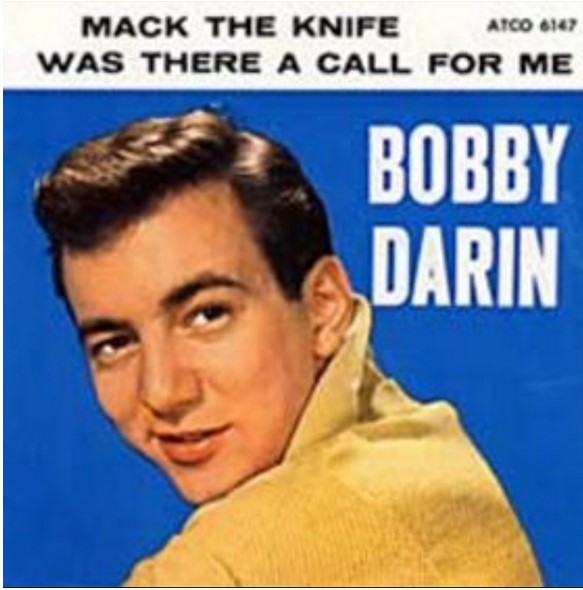
(That is Bobbie Darin, the pop crooner who released the single “Mack the Knife” back in 1958. Mom and Dad had purchased the 45 RPM single and played it on the record player that sate on the table in the corner of the dining room in Birmingham, Michigan).
The tune had a remarkable arc in history and drifted through ours yesterday. The version Bobby sang had some weird names in it- “Suki Tawdry,” for example, is an abbreviation for among others. One of those was a stylish pickpocket nick-named Minnie Diver. Her story came up yesterday, since it was a reprise of the anniversary of her execution in London. Her offense was theft, and given our current infatuation with our changing system of justice, it led through two centuries of turmoil to Germany with new tunes and lyrics.
There are shark’s teeth, cement bags, a stabbing and repeated references to flashing cut-throat Macheath, better known in modern times as Mack, the man with the knife. We were more interested in the curious litany of ladies in the sixth verse:
“Suky Tawdry, Jenny Diver
Lotte Lenya, sweet Lucy Brown
Yes, the line forms on the right, dears
Now that Mackheath’s back in town!”
What caught our attention was the way justice was served in the days when professional criminals were arrested, tried and hung for a variety of offenses that now result only in a trip to the police station and speedy release.
The story, or at least part of it, goes back to Jenny Diver in 1700. She was a notorious Irish thief, and was famous in her career after relocating to England. She was the illegitimate daughter of a lady’s maid named Harriet Jones who abandoned her to a series of foster homes where she learned a variety of skills, not all of them legal. On the legitimate side was work as a skilled. seamstress. Eventually, she emigrated to London where she became apprenticed to the leader of a gang of pickpockets. She soon became so skilled as a thief that she became the leader of Murphy’s gang and nicknamed was nicknamed ‘Jenny Diver.’
Jenny was described as attractive, educated and well dressed in clothing she could make herself. She was able to mix among wealthy people without attracting suspicion. One of the facets of her legacy was her technique. She would feign a public illness on the street and rob people unseen while handing over the stolen objects to her accomplices. Her most spectacular ruse was the use of false arms, which enabled her to steal while her hands were seemingly visible in her lap.
She was arrested a couple times- in 1733 and ’38- but used a false name to demonstrate no criminal record. Her punishment was deportation, but she managed to bribe her way into passage back to England. On 10 January 1741, she was arrested for a third time while trying to steal the purse from the pocket of a woman. At trial, she defended both herself and an acccomplice against a charge of theft and unlawful return from overseas. Both were sentenced to death. Due to her notoriety as a famous criminal, she was taken to her execution in a mourning carriage. The day after the one dedicated to Saint Patrick she was executed with 19 other condemned. She dressed appropriately in a black gown, hat and veil, and reportedly met eternity with composure.
That is what caught us up sort. An attempted non-violent theft foiled in progress. Verdict? “Death.”
That was softened in Bobby Darin’s version for the more tender sensibilities of the decade that followed the ost violent conflict in human history. But the frame on which the song was constructed included the nicknames, the prostitutes and the line that forms on the right, Babe.
Her story had intrigue and romance, and became a component of a stage show known as “The Beggars Opera” before being adopted as a subject by German composers Kurt Weill and Bertolt Brecht in their 1928 production “The Threepenny Opera.” The tune “Mack the Knife” came back to English and life as a pop tune in the mid 1950’s with Louis Armstrong. Financial Times says that “Bobby Darin took the song by the scruff of the neck” and turned it into the swing classic widely known today.
We will keep an eye out for Jenny, just in case her spirit is still roaming about. But living in these times and reading and hearing about how they used to do things is startling, isn’t it?
Copyright 2024 Vic Socotra
www.vicsocotra.com
Weather Report: Spring in the Mud

(What is the caption to this strange melange of “reports” and alleged “news?” “This stuff is all going on? The staff spent the afternoon updating the updates. Images provided at low-resolution for identification purposes only).
There is political stuff all over this week. Our favorite is not the one going on here, interesting though it is with the major parties apparently having decided their top-of-the-ticket candidates going into their respective conventions some months hence. It is a little different in Russia, where President Putin snagged another six year term with a little over 77% approval rate from a pool of 76 million voters.
The big deal in this one? Maybe a way to peace. Arrias gave us a full report on what Mr. Putin described in his victory speech: “He spoke of a “buffer zone between Russia and Ukraine.” In one ear it sounds like establishing a Demilitarized Zone (DMZ) the like of which has kept the peace since the end of the Forgotten War nearly sixty years ago.
Arrias attempts to make a distinction memes, asking if it is nonsense or a serious gesture? As a military professional, he highlights some of the
obvious issues as to what is possible. Could a buffer zone be made wide enough so weapons can’t cross it? That is an obsolete notion now that the Ukrainians already possess weapons that have penetrated 500 miles into the Russian homeland.
Whether that set of numbers can provide a peaceful framework is unknown. The arsenals filled with the old high-tech have been drawn down across the world, depleting inventories built for the Old Cold. Could a De-Militarized Zone (DMZ) provide an interim, albeit longstanding, solution to the war?
We have mentioned the expanded list of NATO members that have joined since the Warsaw Pact disintegrated. It is still disconcerting to see Estonia, Lithuania, Poland and Sweden as nations now covered by Article 5, the NATO charter provision that stipulates and “attack on one is an attack on all members.”
Despite Mr. Putin’s victory remarks, the alternative is to continue the war. Putin now has six more years of assured power. He cannot be forced from office and can arguably continue the war for as long as he lives.
There is plenty of controversy on whether proposals for a DMZ and uneasy peace could work. His election could enable the Kremlin to impose a full wartime economy and harvest the advantage of population and gross domestic product to replenish the Russian arsenal and army.
The Ukrainians can play that strategy as well. Could a UKR battle force with an additional half million troops (bringing their force to 1.4 million, total) force Russia out of the occupied territory in 2025? Could that include Crimea, lost in 2014?
Arrias predicts such a Ukrainian counter-attack might begin next winter, with duration that might last 6 months. That is a tough road ahead, regardless of which one is taken.
And there is a question that needs to be answered regardless of which path is chosen. If Russia were to defend Crimea, would that cross a Putin Red Line on a response using a nuclear weapons for the safety of Mother Russia? What would be the NATO response?
Copyright 2024 Arrias and Vic Socotra
www.vicsocotra.com
A Little Traveling Music
A Little Traveling Music
By Vic Socotra
(Scroll down for triumphant messaging!)

Socotra House Publishing LLC, Arlington Blvd, Arlington, VA 22203
Please join us this morning for a modicum of merriment. The guys from Production stopped by early yesterday as things we starting to wake up for the week of work. The Project had been sitting neatly in the on-deck circle for months now, and the dates associated with the publication have been corrected to bring them into the current one.
The Medical Adventure caused some delay, and that is a component that many of us share. We had rifled through some of the stranger locomotions we experienced around the planet, including a couple trips to the island of Hispaniola, home to two proud nations. One of them is coming unglued again, and was a central part of our lives and travel for several months a long time ago.
That caused us to disgorge some of the events in this “table of contents.” The events of that time have awakened to the strains of reprise, and led us back to the manuscript that had been languishing through the winter. We had been earnest enough in putting it together, but one afternoon review got us only to the century mark in the page count. We had taken a glimpse of the thrilling conclusion, which had some images brighter in color than we remembered some of the places we claimed to be talking about. Not the one on the cover, displayed above. That is one of us standing with the lovely Burmese activist Mimi Myant-Hui on the grounds of the Shwedagon Pagoda in Yangon, once known as Rangoon. We are following the instructions of the Pagoda-minders and are suitably bare-foot.
That was a fun excursion, about like the one below in which Vic and Congressman Bill Richardson visit the site of the John McCain shoot down in Hanoi, Socialist Republic of Vietnam in 1995, the twentieth year since the Americans had pulled out.
Inline image
(Vic and Rep. Bill Richardson visit the John McCain shoot-down memorial in Hanoi, SRV. All photos Socotra unless otherwise credited).
So, the renewed trouble in Haiti got us to go back and dig the digital manuscript out of the encrypted archive. We had been apprehensive that the second hundred pages of the document would require intervention of indeterminate duration. Maybe some creativity inserted, with a modicum of humor?
You know how that goes. Some of the accounting is still fresh with (relative!) youth now a half-century or more in the traveling past. There are some rollicking accounts of strange travels on trains and boats and whatever those other things are that hurtle overhead. Part of yesterday was attacking the chores that used to be left to an individual called an “editor.”
Those were women and men- forgive us for the ancient terminology- who actually understood pens, papers, words and narrative flow. They could also compile these elements in an approachable and engaging manner. As you know, that is a trade that has been under assault through the last two technical cycles that have changed both home and business. You have seen pictures of people working at “desks” with devices called “pens” daubed in ink.
Evolution works, as best we can tell. Our Mom’s made us take a class called “typing” when we were far enough along in Middle School, and that led swiftly to the slidiing slope that made the keys slide from mechanical motion into production of smooth ones and zeros.
At the moment, we are abandoning the use of full words, which the military and their acronyms did long ago. You know- phrases like “C U L8tr” reduced to something that can be managed with a couple thumbs wrapped around a thin rectangular device that is almost always out of charge. But when so charged, it can shout at the bearer of the device, if held close enough to the face, and snap a picture.
We have complained about things like “disclaimers” and acronyms without obvious meanings, like “ISBNs.” Those are the International Standard Book Numbers, a 13-digit string of digits that enables tracking and sales of manuscripts of blather as actual volumes of words. The compilation of that data took a couple hours, but with the deletion of the erroneous conclusion, we realized the book was done. Here is some of it recently compiled for truth, retrieval and accuracy:
Publishing Info/ISBN:
A Little Traveling Music
Tour Guide for Trouble
by Vic Socotra
Copyright 2023 Vic Socotra
Socotra House Publications LLC
4501 Arlington Blvd, Suite 118
Arlington, VA 22203
ISBN Numbers:
979-8-89412-892-4 A Little Traveling Music (Electronic) 18 March 2024
979-8-89412-893-1 A little Traveling Music (Paperback) 18 March 2024
Table of Contents
Introduction: Sea the World
Lost on the Way to the Lobby
Ancient Echoes: The Canal Zone
Let’s Get the Small Stuff Out of the Way
‘Roo Bars
The Middle Part
The Eighties in DC
Manger Square
The Mysterious East
Haiti Daze
The Official Version
The Russians Are Coming
Turn About is Fair Play: Going to the Russians +++++++++
Travels With Pete
STAFFDEL Wagner and the War in Europe
Hostile Fire Pay at the Five-Star Hotel +++++++++
Pariah State World Tour
Ninety Miles to Damascus
Fountain in the Moonlight Square
Channel Fever
There was a fair amount of relief in the Writer’s Section. We will probably lurching into production so those burly bellowing fellows from the Print Shop have something to occupy their afternoon. Meanwhile, the newest volume is something called “Living in the Fall.” We were originally going to call it “Life at the Fall of Rome,” but you can see that would naturally drag us back to travel tales and attacks by Gypsies on the Spanish Stairs.
We will keep you posted on how the Print Shop gang is doing on that, while we move to assembly of the newest book. We don’t know what the end of that one is going to look like yet. The intent is clear, though. We are trying to convey the way we are all feeling in a time that evokes memories of the Visigoths coming in to wave at the ruins of the Colosseum.
The books we have about the time Rome fell condenses it to something brief and dramatic. Trying to capture what is happening to us now has not featured either brevity or drama. Stay with us- we will generate something about the Supreme Court (SCOTUS) decisions on use of social media this afternoon. Some of it may make sense as this astonishing history collapses upon us!
Copyright 2024 Vic Socotra
www.vicsocotra.com
Arrias: Evacuation Day
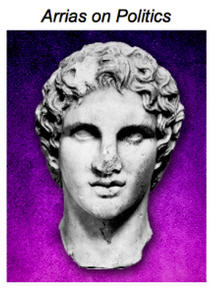 The story really begins yesterday, on June 17th, 1775.
The story really begins yesterday, on June 17th, 1775.
But my real grasp of it began nearly 200 years later, on an early March day, while I was in high school. My mom was having a big party as a fund raiser for the hospital where my dad worked. We had a large, mostly unused room on one end of the house and it had been decorated and tables set up and all that. And we needed to get the fire going in the fireplace. My uncle Bill (everybody in the extended family seemed to be involved doing something) was responsible for fires, and the house had a bunch of fireplaces. So we needed a lot of kindling. Bill looked at me and said: “Let’s go.”
So, off we went. The kindling was at his house, less than 2 miles away. We took a detour… about a 2 hour detour. We ended up on Dorchester Heights, and Bill pointed out where the gun emplacements had been; as an old artilleryman, he knew the exact spot of each battery.
So, back to June 17th, 1775. Actually, a few days before that the “Committee on Safety” had received word that the British were going to occupy Charlestown. To those familiar with Boston today, Charlestown (and Boston) looks nothing like it did then, as a result of a great deal of landfill in the intervening years. At the time it was almost an island, connected by a narrow neck of land. Charlestown itself was shaped somewhat like a triangle, and two hills dominated it, Breed’s Hill in the center, and Bunker Hill a bit to the west, just east of the narrow neck that led to Charlestown.
General Israel Putnam was ordered to prepare to defend against the British attack. Putnam set up the defenses on Bunker and Breed’s Hills. Colonel William Prescott’s regiment was the main force on the hills, and to make a long story short, despite the relative lack of experience of the “rebels” (the Americans) and the experience of the British, the fight that followed was hard-fought and bloody. Three times the Briths attacked and the third attack carried the day, but the Rebels withdrew in fairly good order and made it over the neck and back into Boston.
One of the disconcerting issues for the attacking British is that the “Rebels” held their fire until the British were fairly close; this is where the – probably apocryphal – order was given. reportedly by Putnam: “Don’t fire until you can see the white’s of their eyes.”
Though probably a myth, the American’s held fire until the British were very close and there was a very high number of casualties for an engagement of this size.
British losses were quite high, with more than 1,000 killed and wounded out of a force of 3,000. This included more than 80 officers. The Rebels, who were outnumbered (there were only 2,400) suffered some 450 killed and wounded, and most of them escaped. A recent review of diaries and letters from both the rebels on the hill and the British Army troopers trying to get top the hill has allowed a fairly detailed count of how much ammunition those pesky farmers had, and how many wounds were suffered by the British.
The material suggests that more than 1% of the rounds fired actually hit home, a success rate that has been matched or bettered by only a handful of batters in history. The British Army won, but they had been badly blooded, had developed a very healthy respect for the “embattled farmers,” and the rag-tag rebels had managed to withdraw in fairly good order.
Evidence of the concern, shortly after the after action report came out, and General Gage, the British “tactical commander,” was relieved.
An uneasy standoff now developed, but, still, the British held Boston.
On July 2nd a new commander arrived, George Washington, with the goal of forcing the British out of Boston. This wouldn’t be easy, as the Royal Navy had obvious control of the sea, and the Americans had no means to strike the British positions in Boston. All they could do was hold the perimeter and try to counter a British attack if it occurred. Washington wanted to attack, but there were no plans that any of his staff could develop that looked like it would succeed.
And there was one problem, a problem Washington noted as soon as he had arrived: the Americans had no cannons.
Until Henry Knox came up with an idea (it’s not crystal clear in the records that Knox came up with the idea, some suggest Benedict Arnold. But Washington gave it to Knox to execute the plan, so it would seem to be a good bet that it was Knox’s idea.)
Knox was a local Bostonian who owned a book store; he was a large, friendly man, very well read, particularly in military science, engineering and history, he was wicked smart and he had the heart of lion; he was 25 years old.
At the south end of Lake Champlain lay Ft. Ticonderoga, overlooking the Narrows that, just a few miles further north, open up into the Lake itself. In May of 1775 the fort had been taken by Ethan Allen and his Green Mountain Boys, and this included more than 60 cannons.
Knox plan was simple stated: take the cannons from Ft Ticonderoga and bring them to Boston. On November 15th, 1775, Knox left Washington’s camp in Cambridge with orders to bring the cannons to Boston.
By December 10th they had arrived at FT Ticonderoga, surveyed the cannons, picked 59 that they wished to move and had moved them the three miles to the northern tip of Lake George. The plan was to move them by boat the length of the lake, then put them on sleds and move the cannon south to Glen Falls, then roughly follow the Hudson River to just south of Albany. Then they would follow the roads that, over the next two centuries, evolved into the Massachusetts Turnpike (Interstate 90). It involved 42 large sleds (sleds rather than wagons as it was winter), covering a distance of 300 miles.
The move down Lake George started out well, then the temperature dropped and they finished the 2nd day on the lake – and reached Ft George at the south end. Then they hacked their way through new ice on the lake.
Heading further south they had to cross and recross the Hudson River four times. In early January they still had one more crossing of the Hudson to acieve. In the effort, the ice broke and they lost one cannon. After getting all the sleds across, they went back to the river, back into the river, and recovered the cannon.
Further progress was slowed by, at first, a lack of snow, making the pulling of sleds hard work for the oxen. In the case of moving downhill onto hills and mountains of western Massachusetts, the difficulty in controlling the sleds was a challenge, since they tended to move faster than the oxen pulling them.
But they reached Cambridge on January 25th – with all 59 cannons.
Now, what to do?
If you look at a map of Boston today, look at South Boston and find West 2nd Street. That would be the beach at low tide, and the shore turned at the south-east end of the road where it runs into Emerson. Then it arced up a little to the north as it headed east, all the way out to Farragut Road. Behind that lien rose Dorchester Heights; north and east of that line was Boston Harbor (all the other land was filled in after 1880).
At this point Washington had riflemen moving about on Dorchester Heights, but he was aware that if the British saw the Americans starting to build fortifications and firing positions on the Heights, they would attack and there was little he could do to stop them. He needed to get the guns in position, behind real barricades, and he needed to give the British no time to react.
At this point Rufus Putnam of Braintree came on the scene. He was a 38-year-old cousin of Washington’s general, Israel Putnam and had served as an engineer with the British army during the French and Indian War and had a little experience building fortifications. Washington asked Putnam to offer a solution. Putnam, at a bit of a loss for ideas, asked General William Heath of Roxbury – who had given Putnam’s instruction to name it Washington – if he had any answers. What Heath had was a book: “Attack and Defense of Fortified Places.”
After begging Heath to let him borrow the book, Putnam started reading and developed the answer: What are known as “chandeliers,” a wooden barricade designed to sit on hard ground. Washington took note; what followed was, as the British later said, nearly magical. The Americans built a series of chandeliers, and a host of other parts to make not only a series of barricaded barriers, but also ways to mask the movement of the guns to the heights, to include moving hundreds of huge bales of hay into positions where they could be used to block the British line of sight as they arrayed the cannons.
Washington picked March 4th to begin the operation, knowing that if the British were to attack when they discovered the American effort, the attack would take place on March 5th, the 6th anniversary of the Boston Massacre.
On March 4th, as night fell (sunset was 5:35), hundreds of bales of hay were moved along the side of the road from Roxbury into Boston, obstructing the British view of the road from Boston, and then they began to move the chandeliers, and barrels full of of gravel and cannons and all the other parts to the fortifications. It was 350 carts in all, with 3,000 soldiers acting as laborers, plus two battalions riflemen of 400 men each for security – all headed to Dorchester Heights. By 10PM, two forts had been set up.
British sentries in Boston noted “work on Dorchester Heights,” but no action was taken.
The next morning the British woke to find the two forts on Dorchester Heights. As one officer noted: “They were all raised during the night with an expedition equal to that of the Genii belonging to Aladdin’s wonderful lamp.”
In fact, the Americans had inadequate amounts of gunpowder or shot and shell. But what began the fight was regular shelling at relatively low rates of fire. The first day was of little note. The second day caused some damage and some casualties. The British high command met, and on the 7th decided that an attack up the heights, as with Bunker Hill, but this time facing cannon as well as the American riflemen, would be catastrophic. On the 8th they sent over a request to Washington under a white flag: they would depart and not burn the city if the Americans would let them evacuate.
And so, on Sunday, March 17th, 1776, at 9AM, the last British troops left Boston.
And that is why March 17th in Boston is known as Evacuation Day as well as St. Patrick’s Day.
And we still got home in time to start the fires.
Copyright 2024 Arrias
www.vicsocotra.com
Putin Wins Election with 87% of Vote

This just in, yawn. We will do a more comedic approach for the broader audience, but this one is straightforward. Preliminary results indicate a huge victory for Vladimir Putin, but “thousands protest at polling stations and Russian embassies worldwide.
TOPSHOT-RUSSIA-POLITICS-PUTIN-PRESSER
Putin’s victory was never in doubt | Pool photo by Alexander Zemlianichenko/AFP via Getty Images
De DENIS LEVEN
BRUSSELS — Vladimir Putin tightened his grip on power, claiming another six-year term as Russian president after a brutally distorted election in which all serious challengers were wiped out before voting began.
With 50 percent of ballots counted, Putin’s tally stood at 87.3 percent of the vote, election officials announced. Turnout was 73.33 percent, according to the latest figures from Russian authorities.
Putin’s victory was never in doubt but this is the biggest share of the vote he has claimed in any of his five presidential election wins since his first in 2000. At 71, he is already the longest serving Russian leader since Papa Josef Stalin. and could go on to beat that record.
An official celebration is scheduled for later today, and the Security Services have been asked to contribute to an accurate count of all ballots, including those mailed from California.
Copyright 2024 Vic Socotra
www.vicsocotra.com
An Election Without Russian Interference
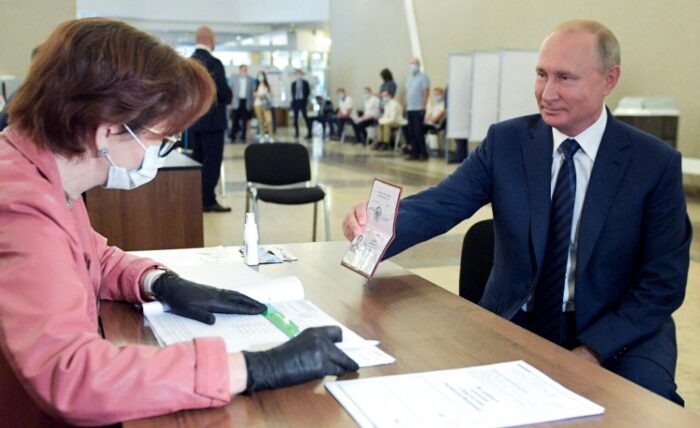
(Vladimir Putin casts a vote at the Kremlin polling station- presumably his. No other protests at the Kremlin were reported, though there were some elsewhere. Photo Kremlin Press Pool via Associated Press).
We made the prediction when the voting began in Russia last Friday. We did not consider it to be a matter that required us to get too far over our ski-tips. It was fun to see something run the way it used to be. This one came off with crisp efficiency, unlike our recent contests here in America. We are having one later this year, and our old-school Primary elections in the two major parties have delivered a rematch of a previous edition.
We think we predicted the results of that one as well. This morning the reporting validates our credentials for accuracy. The nine votes apportioned in the Guam primaries have been allocated, and that pretty much wraps up the top of the ticket for both major parties. There was no word on weather the isle flipped over.
Still uncertain are the candidates who will back up the primary winners. No definitive word on that from either Washington or Moscow. The Russian voting had some familiar sounding numbers and percentages. It was sufficiently familiar to bring hoots of derision on social media on this side of the Atlantic.
You have heard them before. “Putin Secures Another Six Year Term in Office!” was the one least controversial, though it was followed immediately with some users decrying the results as a production of Mr. Putin’s suppression of opposition and manipulation of elections.
As we noted, we have seen this stuff before, both here and there. And elsewhere, as Splash noted proudly after crafting a new slide for Senator Schumer’s remarks to the Israeli Knesset the other day.
On Saint Patrick’s Day, Reuters reported Putin would bring in 88 percent of the vote. It is a little difficult to see who might have acquired the remaining dozen percentage points. There was some meager opposition resembling a shamrock on the ballot from Nikolai Kharitonov of the Communist Party, Leonid Slutsky of the ultra-nationalist Liberal Democratic Party and Vladislav Davankov of the New People’s Party. Voting began Friday, and we presume the 88% for Mr. Putin was counted first.
So, regardless of whatn you may hear, part of the Presidential race this year is settled. We will keep an eye out to see if there is anymore clarification coming at us!
Copyright 2024 Vic Socotra
www.vicsocotra.com
Meanwhile, On the Judicial Front…
SCOTUS bumps across the line from the partisan Lawfare campaign intended to interfere with the election this November, the one that piled up nearly a hundred charges on issues sometimes decades older than the statute of limitations normally permits. Last week’s legal tumult included what is generally considered victories for the defendant, who apparently has the forces of four state-level prosecutors or attorneys-general arrayed against him.
We gave a Sunday morning session to try to figure out the matters unfolding in New York and Georgia. But there is more going on outside the election interference strategy the team supporting the re-election has adopted, and which seems to be unraveling. That would be a mistake in scope that evokes the one employed in the 2016 Campaign.
The one that failed.
We have heard about some of the consequences of that. It raised eyebrows and disputes in the 5th Federal Circuit, and one of them is scheduled to be resolved today.
All right. And the federal government’s alleged censoring of COVID
FOX News
Biden committed the worst First Amendment violation in nation’s history: Andrew Bailey
The Supreme Court on Monday will hear arguments challenging the Biden administration’s alleged coordination with Big Tech to censor certain messages, in a case that one side says could impact the discourse around the 2024 election.
The nine justices will decide if a temporary ban on the Biden administration limiting their communication with social media companies should stay in place while the merits of the case are litigated in lower courts.
Jos. A. Bank Men’s Traveler Collection Tailored Fit Plaid Sportcoat, Brown, 40 Long
Jos. A. Bank Clothiers, Inc.Jos. A. Bank Men’s Traveler Collection Tailored Fit Plaid Sportcoat, Brown, 40 Long
Ad
The case stems from a lawsuit brought by state attorneys general from Missouri and Louisiana that accused high-ranking government officials of working with giant social media companies “under the guise of combating misinformation” that ultimately led to censoring speech on topics that included Hunter Biden’s laptop, COVID-19 origins and the efficacy of face masks.
All right. And the federal government’s alleged censoring of COVID
FOX News
Biden committed the worst First Amendment violation in nation’s history: Andrew Bailey
The Supreme Court on Monday will hear arguments challenging the Biden administration’s alleged coordination with Big Tech to censor certain messages, in a case that one side says could impact the discourse around the 2024 election.
The Press this morning reports that the nine justices will decide if a temporary ban on the Biden administration limiting their communication with social media companies should stay in place while the merits of the case are litigated in lower courts.
There are two in motion on the docket. Today’s case stems from litigation originated by the Attorneys-General of the states of Missouri and Louisiana that accused high-ranking government officials of working with giant social media companies “under the guise of combating misinformation.”
The Constitutional aspect relevant to a SCOTUS decision is about the supresssion that led ultimately to censoring speech on topics including Hunter Biden’s laptop, COVID-19 origins and the efficacy of face masks. The laptop really did belong to Hunter, Covid-19 had a few issues associated with the outbreak, and the masks didn’t actually prevent much of anything.
We saw an earnest-appearing person striding out in the parking lot by herself yesterday, fully masked. Many of us had time in Japan and Korea when we served the nation. The tradition there is that if you feel a mask may help you avoid illness, wear one. But don’t waste anyone’s time explaining why, because the Japanese think it is a personal, not a national decision.
More later. We may see how some of this goes today!
Copyright 2024 Vic Socotra
www.vicsocotra.com
What Color is the Day?

This was one of our Big Days, back when they still had relative sizes. There would be a general destination specified and an approximate set time to arrive Kitty O’Shea’s (11:00 Opening) or Ireland’s Four Courts (10:30) sometime this morning for a pint or four. We do not have that sort of stamina in the Writer’s Section at Socotra House, and tried to unscramble the mass of un-congealed mis-dis & mal information that needs to be manipulated into some consistency with larger messaging campaigns by tomorrow morning.
We thought some activity restricted to The Patio might be a better approach. There was a suggestion of pouring green-tinged fluids on the black asphalt, but realized that could get the Legal Section in a taller uproar than usual on a Sunday and dropped the idea. But we did decide to pay a little tribute to the Chairman’s family, since the O’Socotras of yore were a hearty bunch.
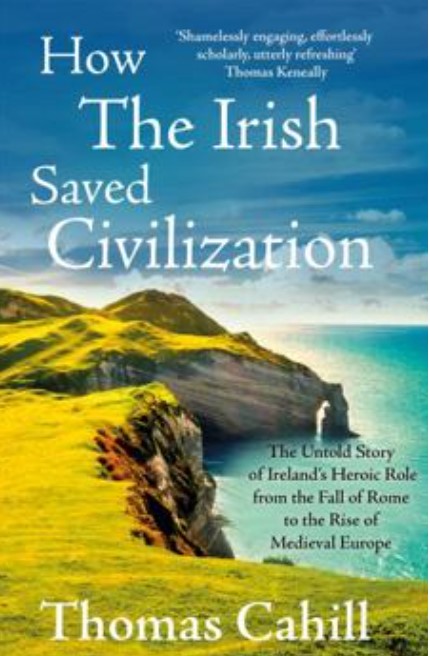
We read some of Thomas Cahill’s marvelous book “How the Irish Saved Civilization” several years ago. He cited the seminal contribution to Western Civilization of the toiling Irish scribes who copied the literature of Greece and Imperial Rome and preserved the glory that was to be reflected in the glory to come.
The monks scoured barbarian Europe for manuscripts in the same manner the Writer’s Section searched for suds this morning. This is a dual-hazard day of tribute to Saints, since the Virginia ABC outlets are closed, and reminding ourselves today to shop yesterday has not been an effective strategy. So, we leaned into our efforts with Cahill.
He tells the story of Europe’s evolution from classical Rome to the medieval era. Without Ireland, Cahill argues, the transition could not have taken place. Not only did Irish monks and scribes maintain the very record of Western civilization, they brought their uniquely Irish world-view to the task.
That is where things get confused enough to merit inclusion in our modern celebration of Patrick’s Day. But what is most significant to us is not the happy circumstance by which the Irish Monks saved the knowledge of classical times. Rather, it is Cahill’s succinct account of how Rome’s Empire of eleven centuries fell with barely a whimper to the Goths and Gauls and Vandals.
During the centuries all of Ireland was ruled by the British, the rulers preferred the hue of “blue.” They even assigned a particular shade resembling that of the clear sky to Saint Patrick, but the azure color fell into disfavor among the Irish. Henry VIII declared himself king of Ireland in 1541, and he gave Ireland a coat of arms all its own: the image of a golden harp on a background of blue named for the Saint.
In the late 1700s, the association between blue and St. Patrick continued to swirl. George III did not spend all his free time persecuting rebels in North America. He also created a new order of chivalry, the Order of St. Patrick. The official color was sky blue.
The ever-rebellious Irish wrestled against the British. They had chosen a different color. They preferred green, the color of the shamrock with which Patrick used to explain Christian beliefs to the Irish he met after he was kidnapped by them. The significance of the three-leafed shamrock was the teaching point Patrick used to describe the three forms of divinity- Father, Son and Holy Spirit- to convert early Irish people to Christianity.
In the Great Irish Rebellion of 1641, Irish military leader Owen Roe O’Neill’s sailing vessels flew a flag that depicted an Irish harp. A harp on a field of green instead of blue, An Englishman named Thomas Dineley traveled through Ireland in 1681 and “reported people wearing crosses of green ribbon in their hats on Saint Patrick’s Day.”
The moment of a rebellion formed in color arrived in the late 1700s. An underground group sought to emulate the successful American Revolution against the Crown. To avoid being spotted by the English, an Irish nationalist might wear a subtle hint of green, such as a green feather in his cap. The poorly-armed rebels were crushed by the British as usual, but the idea of wearing shamrocks attached to hats and the color green as nationalist symbols persisted through the years.
A street ballad titled “The Wearin’ o’ The Green” was written anonymously around 1798. It conveyed a distinctly rebellious meaning in a time of (almost) uncontrolled ex-migration. The commonality of issues across our centuries is striking, you know? Here this week it is migration- albeit from the South- and taxes.
That issue has been around since Rome left, retaining status as a common irritant across the last thousand years of our common history. The President’s Budget for Fiscal 2025 just got rolled out by the people on the other side of our common River. It contains the varieties of mathematic lunacy we support regularly on your behalf.
That is something to raise a glass to on this day, don’t you think? We have some notes about other ones. that Saint Patrick’s Day was not just blue, instead of Green, but it was the irish Tourist Board that suggested this day might be a good one for a pint or five.
We decided to agree, and Splash brought a shamrock to the morning meeting. “Ireland’s Own” doesn’t open for a couple hours, you know?
Copyright 2010 Vic Socotra
www.vicsocotra.com
The Memo From Legal
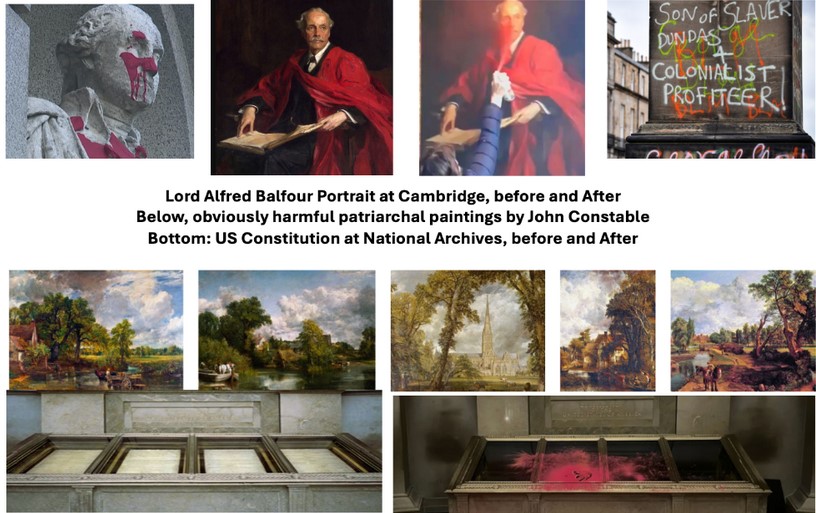
The memorandum in formal script- Gramond, we thought- was an unusual feature on this lovely morning. The day, and the memo, both got our attention, since they both started out a bit chill. It was a bit like night, nature, and nurturing were bidding farewell to a winter thankfully sliding into the past. And it is the past itself that appears under assault this morning.
The legal note said it was a matter of corporate self-defense on their part. They were probably referring to the spectacular clip of the shooting on the New York Subway this week. That was a new outrage sandwiched into the Daniel Penny case still grinding forward. He is the ex-Marine accused of slaying a homeless man who was attacking riders on a sealed car a few months ago. The new case features National Guard deployments, righteous Governors and more startling violence. The context is what gets lost on the Friday dump of the mess we deal with on Saturdays. In eekend time, it just reflects the changing context about safety and disintegrating public order. The one we are told is actually getting better.
The Legal Section is of course opposed to violence, but mostly concerned about liability for a possible perception of being overly aggressive in coverage.
You know how the cycle goes. Information produced in the working week reflects stuff that has gone viral in social media. Some of it is caught and packaged to properly display correct messaging, since it could be inconvenient if not packaged properly. Like Senator Schumer’s strange remarks about the current leader of Israel. Accordingly, controversial matters are packaged up on the weekend in a manner that be easily storied in the memory hole until they figure out what can plausibly sold on Monday in support of things we are supposed to accept as truthful.
So, Saturdays we have a chance to see the last of the stories that will disappear before the new week. The Memo from Legal contained partial guidance on how to proceed with a story that had been in progress and would have been memory-holed except it continues to pop up. Our irreverent scribe Splash has been keeping some of the stories in packaging that does not reflect official messaging, but which may be noted as independent and not an official position. Our legal position is that use is justified as personal, not corporate. Splash is an independent contractor whose views do not necessarily reflect those of management. Or the low-resolution images he used for identification only.
Like the ones that set him off this morning. He had worked on the story of the removal of the Confederate reconciliation memorial over at Arlington. For our Army members, it was as visceral as dropping the “Duty, Honor, Country” from the West Point mission statement that was announced this week. It follows the VA’s dismissal and subsequent restoration of the picture of that impassioned kiss the Sailor bestowed on the nurse commemorating the end of World War II. He had made a brief scene in the circle at the Friday meeting that marks the transition from caffeine to alcohol. As a group, we are opposed to the destruction of public property, or at least a discussion about why it is necessary. Maybe before it happens. The various activities- blocking streets, shouting “River to the Sea” and stuff has been interesting. But there was another string of data about that.
That’s where Lord Arthur Balfour briefly appears in newer news than he has used to. His portrait, before during and after the Wednesday event, was striking. A quick aside for context. Arthur James Balfour was the First Earl of Balfour. He served at the zenith of what used to be known as the British Empire. He had- and still has, we assume- a string of initials after his title and name. They include the ones signifying membership as a Knight of the Garter and some others whose provenance is currently undetermined to English speakers on the west shore of the Atlantic ocean. He was Prime Minister a couple times- a Conservative PM, a term that has acquired new meaning(s) but as Foreign Secretary in 1917 issued the “Balfour Declaration” in 1917. The short memory is to recall the memo as supporting a “home for the Jewish People” in a place called Palestine. The parts that are left our include the most massive conflict in human history still in progress, and the collapse of the Ottoman Empire which had conquered the area after Rome’s massive collapse.
But Lord Balfour takes the wrap for allocating territory to which modern activists claim he had no authority to dispense. Thenprotrait of him that was defaced was done in 1914, and has hung mostly in honor since it was placed on the wall in Cambridge.
The graphic that starts this one is not intended to be partisan. It just captures something that is as extraordinary for what is not happening as what is. It is reflected in many of the graphic social anomaiies now routinely captured on cell-phone video and festooned on screens around the world. That peripheral point? No one is doing anything about it.
In the case of Lord Balfour, addition of context helps the analysis. There is more to the scene. Not included is the someone with a phone up to face to capture the video. Then, the individual in the down coat produces the spray-can of paint, which is described as having some vile additive substance contained in the tint. Then the physical attack on the canvas occurs with a steel blade, leaving his Lordship bereft of a midsection.
The other images are just contextual. Famous landscape artist John Constable, slightly earlier in era than Lord Balfour, is now under assault for his clearly patriarchal and Colonial Settler landscapes. New interpretations suggest there are some pervasive nationalist flaws in the art and the English character. The string at the bottom of the graphic represents the recent attempted defacement of the US Constitution.
That one had the same drill as the assault on Lord Balfour. The level of outrage it caused was higher here, of course, since we swore a personal oath to it. But the Founding Document shares shomething with the former prime minister. No one- including armed guards almost in the frame- did a darned thing about the defacement while it was being set up and in progress. This is an institution fully alarmed, all on camera, and protected by armed guards a few feet distant. The. whole thing strikes us as absurd as the Greta Thunberg media campaign. Or Climate Czar John Kerry.
The Archives claim the Constitution was unaffected and safe in its enclosure. “No damage was done to the document itself.” they said in a statement. That is a relief, of course, and we understand there were legible copies of the document made since it was written not-quite a quarter thousand years ago. But the people here- not exclusively white males- who swore allegiance to it are sort of irritated. Legal says to use that word instead of ‘pissed off.’ That phrase can now apparently be uttered on the media, though preferably by the contractor community. Or allegiance to the ideas contained in the document under the dust and glass and bathed in a preservative atmosphere.
What is interesting is that the Archives mission has changed, like the Army’s. They are now not considered to be just a responsible repository, but to be an instrument used to re-organize the past in a more palatable manner. That seems to be the theme on all this, and worthy of the Memo From Legal. We will use it if the legal spotlight comes our way!
Copyright 2024 Vic Socotra
www.vicsocotra.com
GOP Skirmishes- Senate

Afternoon, Gang! This is worth a quick catch up in the battles in progress on The Hill. We have been exposed to the strange gyrations in the Senate lately. Sen. McConnell just stepped down as the longest GOP leader on the Senate side. Seeking to relieve him as the Senate’s #2 official are Texas Sen. Cornyn and South Dakota’s John Thune. The Dems, personified by Majority Leader Schumer, made an attempt to unseat the Prime Minister of Israel the other day in remarks on the Senate floor. It was, part of a fight between Israeli and Palestinian proponents in the party base.
Considering that Election issues are rampant here at the moment, they are also apparently in progress for everyone everywhere. The idea we have an internal conflict over election interference while taking the Senate floor to call for someone else’s election continues the rich vein of comedy in this season of dramatic change.
The GOP is also in a swirl. As of the 25th of this month, their lead on the Junior side diminishes to a single seat with another resignation. There is conflict in their party on that side, and tumult on the Senate side for how they are going to challenge the Senate leadership. Both sides are looking for change.
#2 Senate GOP (Whip)- don’t get confused- this is the GOP#2, not the Minority Leader. The ex-president has endorsed Senator John Barrasso for the number two GOP Senate spot Thursday night. He is currently Number three. Two other GOP Senators have announced plans to replace Senator McConnell as Minority Leader:
“John Barrasso is a fantastic Senator for the incredible people of Wyoming,” Trump wrote in a social media post. His endorsement is an interesting reflection on the Constitution’s Electoral College, always considered a bulwark of protection for the majority of citizens against the vagaries of the masses of citizenry in places like New York and California. The GOP Senate line will be set for the summer.
The College is under attack as an institution, as is the Supreme Court, while another one, the Executive Branch agencies, have assumed a role for which there is little justification. There is also a divisive strain in the Religion of Peace, or whatever we are calling it. Saudi Arabia leads the Sunni segment of the fait, and Iran the Shias. The Shia side seems to have an advantage under the current line-up, with billions more in aid going to Tehran this week. They are a curious group to be handing cash to, but that is the surreal nature of our political landscape these days. We don’t even know who is running our White House!
It would help the drafting of our new book if we did!
JR
Copyright 2024 Vic Socotra
www.vicsocotra.com
